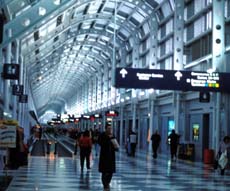index
The global soul
click on images for full-size:




Visible linking

A connection that can make one discontinuous place.

Discontinuous parts of the one hub, with many linked corridors
Pico Iyer has written about people who live almost unceasingly on the transportation and communication networks, people such as international journalists, management consultants, salespeople, couriers, and the like (Iyer 2000a Iyer 2000a). I suggest that such people inhabit a dispersed place made up of separate spaces united by similar textures and providing an expanse across which unified actions are carried out. This air-travel-hotels-lounges-shops-telecom assemblage could be a single place. Not just a set of more or less identical locales, but a unified yet dispersed spatiality for normative trajectories of action and communication. This connection of locations and media offers a discontinuous spatial expanse that can be grammatically structured in terms of appropriate actions and social roles uniquely embodied as transitions and maneuvers and "bodily" gestures within the dispersed spatiality. The rapidity of travel and the uniformity of its stations help unify these discontinuous spaces. Unlike slower travel on an ocean liner, there is little time for me to interrupt concentration, and the halo of possibilities and norms that give meaning to actions remains constituted by the work-travel-telecom assemblage. The intervening spaces are "on the network" rather than interruptive "betweens." The body gets extended. Fax and email and phone connections can act like the cane of a blind person exploring the environment. The edge of the blind person's body is out at the tip of the cane. When driving a car my body at times extends to the fender that I scrape on a tree. As a fast traveling consultant, my body could extend out into the larger space at the edge of my exploring media cane. Identifying this complex of networks as a place does not imply that it is a "good" place -- its actions and roles are thin* and lack complexity. These are the locales that Marc Augé identifies as "non-places" without any proper connection with thick anthropological identities (Augé 1995). Iyer might reply that there is a new kind of identity at work in this network, an identity whose problematic contours are not so much dis-placed as in a new global place.